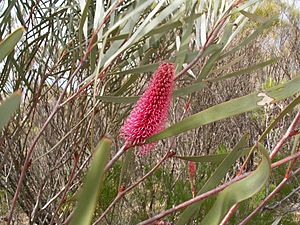Emu tree facts for kids
Quick facts for kids Emu tree |
|
|---|---|
 |
|
| Scientific classification | |
| Genus: |
Hakea
|
| Species: |
francisiana
|
 |
|
| Occurrence data from AVH | |
The Hakea francisiana, often called the emu tree, grass-leaf hakea, or bottlebrush hakea, is a type of shrub or small tree. It belongs to the Hakea plant group and grows naturally in Western Australia and South Australia.
Contents
What the Emu Tree Looks Like
This plant is usually a shrub or a small tree that can grow from 3 to 8 metres (9.8 to 26.2 ft) tall. It has a shape like a "V" and its bark feels rough. Its leaves stay green all year round. They are long and thin, about 15 centimetres (5.9 in) long and 3 millimetres (0.118 in) wide.
The emu tree blooms with beautiful pink-red flowers from July to October. These flowers grow in big bunches, called racemes, which can be up to 10 centimetres (3.9 in) long. You'll find them growing where the leaves meet the stem during winter and spring. Most flowers are red or reddish-purple. However, some types, once known as H.coriacea, have creamy flowers with a pink center.
After the flowers fade, woody seed pods form. These pods are about 20 mm (0.79 in) long and hold two seeds with wings. The pods usually open and release their seeds under special conditions, like after a bushfire. The emu tree looks very similar to other plants like Hakea bucculenta and Hakea multilineata.
How the Emu Tree Got Its Name
The Hakea francisiana was first officially described by a botanist named Ferdinand von Mueller in 1858. He wrote about it in his work called Fragmenta Phytographiae Australiae.
The plant's scientific name, francisiana, was chosen to honor George William Francis. He was the very first director of the Adelaide Botanic Garden in Australia, working there from 1857 to 1865.
Where the Emu Tree Grows
The emu tree is a plant that is only found in certain areas, meaning it is endemic to those places. It grows in parts of Western Australia, including the Wheatbelt, Mid West, and Goldfields-Esperance regions. You can find it from Geraldton in the west, up to Wiluna in the north, down to Lake Grace in the south, and stretching into the Great Victoria Desert in the east. It also grows in the western parts of South Australia.
This plant prefers to grow on sandy plains. It can be found in sandy-clay, loam, or clay soils, often where there is gravel and quartz rock. It usually grows as part of mallee woodland and shrubland plant communities.
Growing the Emu Tree
If you want to grow an emu tree, it needs a spot with lots of sunshine. It doesn't need much watering once it's established. This plant is great for gardens because it's pretty and provides a home for birds and bees.
The emu tree is tough! It can handle drought (long periods without rain), lime in the soil, and even light to moderate frost. Sometimes, people will graft this plant onto a different, stronger root system to help it grow even better.

